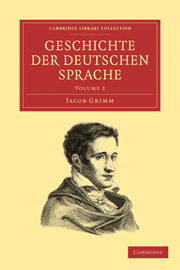Book contents
- Frontmatter
- XXI HESSEN UND BATAVEN
- XXII HERMUNDUREN
- XXIII DIE NIEDERDEUTSCHEN
- XXIV FRIESEN UND CHAUKEN
- XXV LANGOBARDEN UND BURGUNDEN
- XXVI DIE UBRIGEN OSTSTÄMME
- XXVII SCANDINAVIEN
- XXVIII DIE EDDA
- XXIX GERMANEN UND DEUTSCHE
- XXX RÜCKBLICK
- XXXI DEUTSCHE DIALECTE
- XXXII DER ABLAUT
- XXXIII DIE REDUPLICATION
- XXXIV SCHWACHE VERBA
- XXXV VERSCHOBNES PRAETERITUM
- XXXVI DIE VOCALE DER DECLINATION
- XXXVII DER INSTRUMENTALIS
- XXXVIII SCHWACHE NOMINA
- XXXIX DER DUALIS
- XL RECHT UND LINK
- XLI MILCH UND FLEISCH
- XLII SCHLUSS
- Bemerkte druckfehler, lies
XXXV - VERSCHOBNES PRAETERITUM
Published online by Cambridge University Press: 29 August 2010
- Frontmatter
- XXI HESSEN UND BATAVEN
- XXII HERMUNDUREN
- XXIII DIE NIEDERDEUTSCHEN
- XXIV FRIESEN UND CHAUKEN
- XXV LANGOBARDEN UND BURGUNDEN
- XXVI DIE UBRIGEN OSTSTÄMME
- XXVII SCANDINAVIEN
- XXVIII DIE EDDA
- XXIX GERMANEN UND DEUTSCHE
- XXX RÜCKBLICK
- XXXI DEUTSCHE DIALECTE
- XXXII DER ABLAUT
- XXXIII DIE REDUPLICATION
- XXXIV SCHWACHE VERBA
- XXXV VERSCHOBNES PRAETERITUM
- XXXVI DIE VOCALE DER DECLINATION
- XXXVII DER INSTRUMENTALIS
- XXXVIII SCHWACHE NOMINA
- XXXIX DER DUALIS
- XL RECHT UND LINK
- XLI MILCH UND FLEISCH
- XLII SCHLUSS
- Bemerkte druckfehler, lies
Summary
Wir sahen vocale durch ablaut, consonanten durch verschiebung gewandelt; warum sollte der sprachgeist nicht auch versuchen ganze formen vor oder zurück zu schieben, ihnen dadurch andern sinn zu verleihen und nebenformen daraus hervorgehn zu lassen? solche übergänge werden vorzugsweise für die tempora zu erwarten sein.
Es verdient schon aufmerksamkeit, dals einzelne verba dem praesens bedeutuug des futurums beilegen. so drückt das ags. beo bis biđ gewöhnlich ero, das gr. εἶμι bei den Attikern ibo aus, zu beo fügt sich das sl. budu ero.
Nächst dem trägt es sich zu, dass ablaute des pl. praet. ind., welchen, wie wir wissen, die des gesammten praet. conj. gleich sind, rückwärts steigen und den sg. praet. ind. einnehmen. so gilt uns nhd. neben dem frischeren ward ein abstracteres wurde mit scheinbar schwacher form; das mhd. gan, vergan ist ganz verdrängt durch ein aus dem alten pl. gunnen oder dem conj. günnen stammendes gönnt, mit dem praet. gönnte, und in den sg. der meisten praet. vierter conj. ist heute der pl. ablaut gedrungen, für mhd. sneit reit streit greif reiz sagen wir schnitt ritt stritt grif riss und mitunter hört man sogar sturbe erwurbe f. starb erwarb. Ein weit älteres beispiel des in den ind. gerückten conjunctivs werde ich im verfolg bei dem worte viljan behandeln.
- Type
- Chapter
- Information
- Geschichte der deutschen Sprache , pp. 892 - 910Publisher: Cambridge University PressPrint publication year: 2009First published in: 1848



